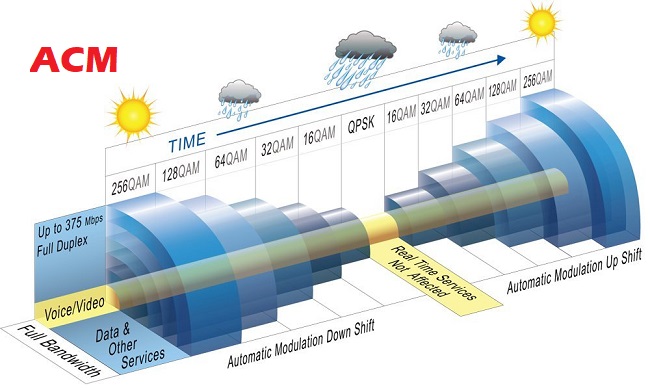Adaptive Coding and Modulation or Link adaptation is a term used in wireless communications to denote the matching of the modulation, coding and other signal and protocol parameters to the conditions on the radio link (e.g. the pathloss, the interference due to signals coming from other transmitters, the sensitivity of the receiver, the available transmitter power margin, etc.). In a digital Microwave Link ACM uses a rate adaptation algorithm that adapts the modulation and coding scheme (MCS) according to the quality of the radio channel, and thus the bit rate and robustness of data transmission. The process of link adaptation is a dynamic one and the signal and protocol parameters change as the radio link conditions change.
 |
| Microwave Adaptive Coding and Modulation (ACM) |
The Goal of Adaptive Coding and Modulation (ACM)
The goal of Adaptive Modulation and Coding is to improve the operational efficiency of Microwave links by increasing network capacity over the existing infrastructure – while reducing sensitivity to environmental interference.
Adaptive Modulation means dynamically varying the modulation in an errorless manner in order to maximize the throughput under momentary propagation conditions. In other words, a system can operate at its maximum throughput under clear sky conditions, and decrease it
gradually under rain fade. For example a link can change from 1024QAM down to QPSK to keep “link alive” without losing connection. Prior to the development of Automatic Coding and Modulation, microwave designers had to design for “worst case” conditions to avoid link outage The benefits of using ACM include: |
| ACM with 1024 QAM Modulation |
-
Longer link lengths (distance)
-
Using smaller antennas (saves on mast space, also often required in residential areas)
-
Higher Availability (link reliability)
Importance to Operators of ACM
Adaptive Coding and Modulation increases the capacity of microwave links without sacrificing distance or availability, and without requiring larger antennas. The penalty – reduced capacity during heavy fade/rainfall – is usually considered an acceptable trade-off compared to the benefits, especially for IP networks where a variable capacity is generally considered acceptable, compared to legacy PDH (NxE1/T1) and SDH connections which are fixed capacity applications. Conversely, ACM allows operators to minimise costs by using smaller antennas, meet higher availability targets (e.g. 99.999% availability) and customer SLA (service level agreement) and also fit within aesthetic and planning constraints in dense urban areas and regions of natural beauty where large antennas may be prohibited by planners or building owners.




Post a Comment